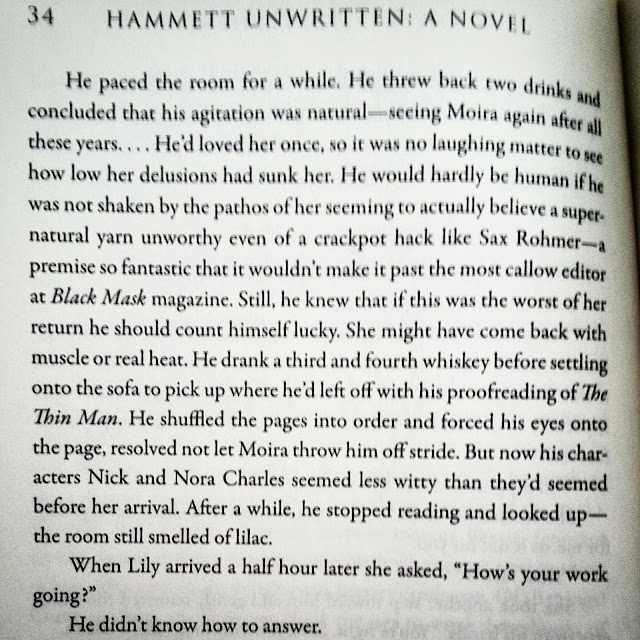Encapsulate the plot of the book in one sentence?
Writer Dashiell Hammet suspects the black falcon statuette he once kept as a momento before giving it away might be a powerful talisman key to his early success...and sharp decline in his career and personal life in its absence.
What's your verdict?
Dashiell Hammet worked as a private detective for the Pinkerton Detective Agency and quit when his writing career blossomed. He did claim that the villains featured in The Maltese Falcon were based on people he encountered while on assignment at Pinkerton's, but the falcon case was pure fiction; the statuette was inspired by a jeweled skull owned by Phil Haultain, a Pinkerton agent who worked with Hammet in the 1920s and kept it in a safe in his office.
Hammet Unwritten is a fictionalized retelling of Hammet's life, particularly the final two and a half decades, in which he seemed to be adrift, creatively, personally and professionally. In 1934, he wrote The Thin Man, his last novel, which inspired a successful film franchise starring William Powell and Myrna Loy as Nick & Nora Charles. He contributed screen story treatments, or "scriptments" for two of the film adaptation's five sequels in the form of short novellas, but otherwise, the remaining years of his life were spent coasting on his celebrity. He often recieved huge advances from publishers for exclusive publishing rights to future novels he would pitch (often he claimed he was working on a novel that sounded like a contemporary take on Swiss Family Robinson) and there is that strange fragment of a novel, Tulip, which was cobbled in with a collection of older short stories after his death, The Big Knockover.
In Unwritten, what we've got is a sequel to Falcon starring Hammet. Gordon McAlpine imagines Hammet's last case for Pinkerton's as "The Black Falcon Affair", imagines Hammet buying the "fake" falcon statuette at a police auction, then giving it away years later to Moira O'Shea, ( the "real" Brigid O'Shaunessey of Falcon ) to humor her outrageous tale that the bird is actually a powerful totem that brings good fortune to whoever owns it. As the novel spans the years after the handover, Hammet keeps having chance encounters with the other "real world" counterparts to his characters, including Joel Cairo and Kasper Gutman, and an encounter with film director John Huston on the set of the classic film adaptation. His slow realization that this falcon might be the real thing leads to the finale, when he gets a chance to get it back.
The Maltese Falcon, in my opinion, is the greatest American Mystery novel ever written. I would also rank it as one of the top 5 greatest mystery/dective novels of all time. If you haven't read it, or only saw the film with Humphrey Bogart, or encountered neither, I don't believe it's necessary to enjoy Hammet Unwritten without having done so. At it's heart, this book is about a man coping with his personal crisis of confidence. Despite the fact that it's fiction, it's a consistent portrayal of the real Dashiell Hammet in his later years. McAlpine must have wanted to imagine a more cinematic biography for those final decades by making Hammet an artist ( and not just a troubled alcoholic ) and setting him on a quest.
What surprises did the book hold, if any?
There's an excellent biography of Dashiell Hammet by Diane Johnson called Dashiell Hammet, which I had read when I was in High School. Nothing in Hammet Unwritten happened to Dashiell Hammet, but the man in this novel is the same man I read about in that biography years ago. In real life, his creative burnout was caused by a lifetime of drinking, a long-standing relationship of convenience (my opinion) with socialite/playwright Lillian Hellman, and lack of motivation for writing more. Plus, in retrospect...his life was half over by the time his last novel had been published.
It's also short, which is a nice surprise. So many books these days tend to be written per quota or weight requirement and suffer for that. A good book does not need to weigh as much as a brick to be entertaining.
Which scenes will stay with you?
Quite a few - there's a scene where Hammet has a reunion with the counterpart to Sam Spade's secretary Effie and finds a dog-earred copy of The Maltese Falcon in her desk drawer. He decides to pencil in some new dialogue in her copy to express his feelings about her in contrast to how the character of Effie was portrayed in the story...and he can't get the words out, nothing comes to him. There's another scene where Hammet's writer's block has gotten so bad that he's begun hoarding typewriter ribbons in hopes that he'll need them, or upgrading to newer typewriters in hope that his output will improve. There's also a scene that suggests his reasons for re-enlisting in the army as a middle-aged man were to get away from the writing desk, even resorting to having his teeth removed after being initially rejected for having bad teeth.
Give us a good quote.
Sure - check out the gallery below.















































